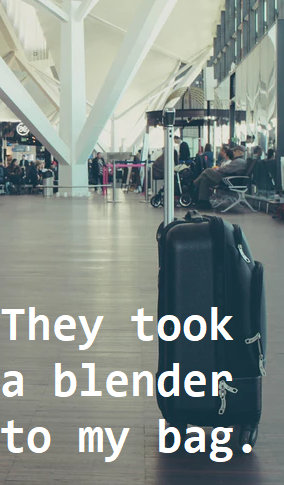
An airline losing your luggage can definitely wreak havoc on your trip, and even complicate your life once you’ve returned home.
Allen Tish, a client and friend of Cook Travel, had a less than positive experience with this. Flying from LA to Paris on Air France and then on to Montenegro, he switched airlines after the Paris leg, but his luggage didn’t switch with him. His bag remained missing for three days, and when he finally got it, (after $60 cab ride back to the airport), he wasn’t happy with what he found. “They took a blender to my bag.”
He had a large bottle of antacids that were strewn everywhere in his clothes and belongings, and his $1500 backgammon board was broken at the hinges. He thinks this might have been the offending item, his backgammon board being a large, rectangular shape with metal pieces. One of the checkers was missing.
All of us feel gripped with anxiety waiting for a bag to come down the conveyor belt. We don’t know when it will show up and in what shape it will be. Less than one percent of luggage is actually lost for good. But if you would prefer not having your luggage lost even temporarily (who wouldn’t?), here are some things you can do to increase the chances that your bag’s journey will be a smooth one.
Arrive early, and avoid short layovers. This will give your bag more time to get through security and onto your flight.
Similarly, when booking your flight, try to get one continuous ticket. Changing air carriers can make it more difficult to track down your bag if it’s lost.
When packing your bag, take pictures: snap the inside of your bag, the outside, and a picture standing next to it (for size). These pictures will help the airlines identify your bag if it’s lost, and you’ll have pictures for insurance if your bag isn’t recovered. On that note, don’t pack anything you couldn’t bear to lose.
Once you’ve packed your belongings, pack a copy of your itinerary in a front pocket in your bag or suitcase along with contact information. This way if your ID tag is damaged, the airlines can still contact you.
After packing, attach identifiers to your luggage (ribbons, tags, etc.) to help you spot your luggage, and prevent hasty travelers from mistaking it as their own. If your luggage is lost, these markers will also help the airlines find your luggage. (With lots of plain black suitcases to search through, your sequined, neon-green ribbons will stick out like a sore thumb, but this is what you want.)
That being said, the only surefire way to avoid a checked bag being lost is not to check one at all. Consider packing light. Or, you could mail your belongings to your destination. (But as for your mail not being lost—sorry, that’s not in our wheelhouse!)

 Save up to 60% on Business Class. Call 1-800-435-8776
Save up to 60% on Business Class. Call 1-800-435-8776
Main suggestion, don’t pack anything of economic or sentimental value, if you have fragile stuff , hand carry or use hardside luggage, lastly learn to pack light, one sport jacket you wear, one extra pair of shoes, 3-4 pair of socks and undies and 4 shirts max one pair casual pants = one carry on .
If you must pack more , make sure you split everything up in the checked bag and the carry aboard. Oh and bring a small detergent to wash things in the sink for emergencies.
Also, copy your passport and take along with you